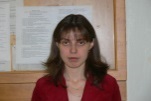
E P Savelova
Bauman Moscow State Technical University, Russia
Title: Dynamical Pauli-Villars regularization
Submitted Date: 29-07-2017
Biography
E P Savelova has her expertise in Theoretical and Mathematical Physics. In 2009, she has completed her PhD in Theoretical Physics (Title of thesis is “Gas of wormholes as the model of dark matter†under the guidance of Prof. Kirillov AA). Between 2012-2016, she was the Associate Professor of Dubna State University and since 2016 she is the Associate Professor of Bauman Moscow State University. She has published 18 papers in reputed journals. Her basic works concern propagation of particles and fields on manifolds with complex topology (gas of wormholes) both in classical and quantum theory, modeling dark matter effects by a gas of wormholes, variation of speed of light by virtual wormholes. The most important result is the proof that virtual wormholes do remove divergences in quantum field theories.
Abstract
Statement of the Problem: Quantum Field Theory (QFT) suffers from the problem of infinities. The simplest example is the vacuum energy density for scalar particles. In 1949 W Pauli and F Villars have suggested a phenomenological scheme for the regularization of such infinities]. It introduces a set of auxiliary particles with very heavy masses. The absence of experimental observations of such particles resulted in the fact that so far the nature of auxiliary masses remains unclear. The purpose of this study is to find the mechanism which may lead to generation of such auxiliary masses and fields. \r\n\r\nMethodology & Theoretical Orientation: It was assumed that space-time foam picture suggested first by J A Wheeler is capable of removing infinites in QFT. At very small distances topology of space-time fluctuates (space-time foam). The most natural description of such a picture is given by a gas of virtual wormholes, or, equivalently, of baby universes. At very small scales a baby universe may branch off and then joint onto our Universe. In classical gravity such processes are forbidden but they take place in quantum gravity as tunneling events. When a free particle propagates through the throat of such a virtual wormhole (i.e., it is captured by baby universe) it acquires the mass even if it was massless initially. The value of the mass is determined by the characteristic radius of the throat. \r\n\r\nConclusion & Significance: It was found that virtual wormholes generate an infinite sequence of auxiliary masses for all kinds of fields. The values of the auxiliary masses are very big and start from the Planck mass value ~ 10-5 g. This makes quantum field theory to be free of infinites. As a by-product it was found that external classical fields change the vacuum distribution of virtual wormholes (the intensity of topology fluctuations). This allows creating, from virtual wormholes, coherent structures which may work already as real wormholes.\r\n\r\n

Carl Strutinski
Geological Institute of Romania (Retired), Germany
Title: An alternative view on subduction zones
Submitted Date: 14-07-2017
Biography
Carl Strutinski studied Geological Sciences at the University of Bucharest. He worked for over 15 years in a geological enterprise for prospection and exploration, and then for another 17 years at the Geological Institute of Romania (Bucharest), studying metamorphism and geotectonics. Since 1990, he published seminal papers on the transcurrence phenomena in mountain building.
Abstract
Statement of the Problem: Conventional models of subduction zones are contradicted by motion direction within the mantle beneath Wadati-Benioff zones, entitling the quest for alternative models. \r\n\r\nPresent View: According to current interpretations, the Earth has not increased its mass/size since its final accretion about 4.5 billion years ago. This standpoint is adopted by the theory of plate tectonics, which, fulfilling its requirements, is compelled to link the evidence of growing oceanic crust along mid-oceanic ridges to a speculation. It states that old crust must plunge into the mantle along subduction zones to compensate for newly created crust. The process is believed to be proved by earthquakes taking place in the inclined Wadati-Benioff zones. \r\n\r\nAlternative Model: Analysis of seismic anisotropy data has shown that the motion direction within the mantle directly beneath Wadati-Benioff zones is mostly at right angles to that implied by the subduction model. It means that the mantle, instead of plunging downwards, creeps horizontally showing a remarkable parallelism to the alignment of subduction zones. In accordance with this finding, my interpretation states that subduction zones are in fact inclined counterparts of doubly bounded transcurrent systems with which they usually merge (Figure 1). Both represent crustal manifestations of the mantle currents beneath. For this reason the tilted structures should be considered as inclined transcurrent systems rather than subduction zones. They are ubiquitous wherever the generating mantle currents have flow directions that differ from the sense of Earth rotation, which lends support to the hypothesis that the tilting may be a combined effect of vertical shear and Coriolis force. The fact that there are no ‘subduction zones’ trending east-west could be explained in this way. Regarding the earthquakes within Wadati-Benioff zones, I interpret them as being caused by mantle outgassing, in accordance with ideas enunciated by Thomas Gold. \r\n
